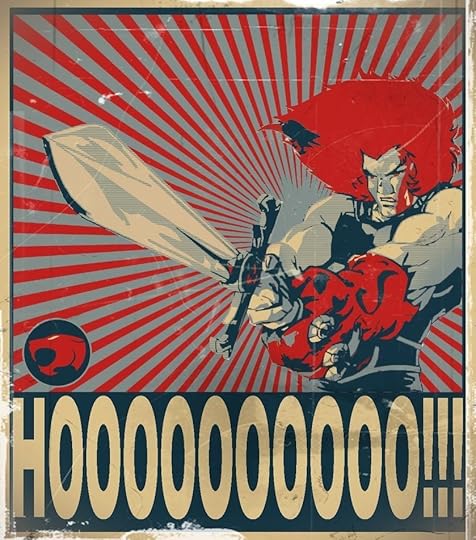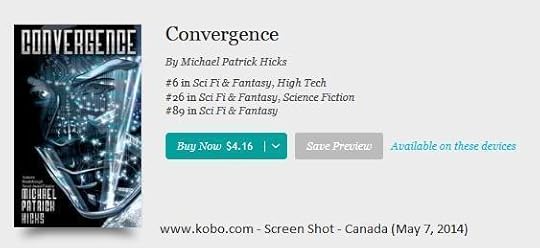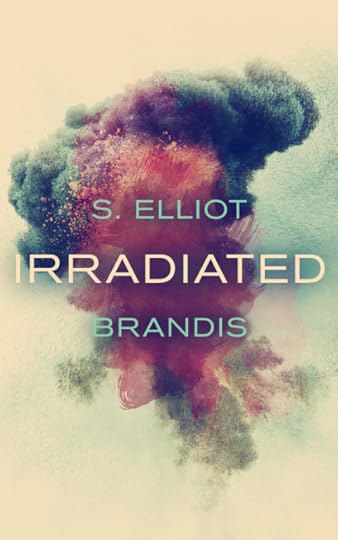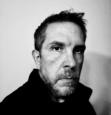Michael Patrick Hicks's Blog, page 85
May 14, 2014
Published: IRRADIATED goes LIVE.
Congrats to S. Elliot Brandis on the release of his book IRRADIATED. His cover designer, and author of the forthcoming ELEANOR, Jason Gurley, did a wonderful job with the design work.
IRRADIATED is the first book in a sci-fi trilogy, with the next two books due out soon. Elliot was kind enough to share an advanced look at Gurley’s art for the follow-ups on KBoard, and they look equally bad-ass. I am really looking forward to checking out this series, as well as Gurley’s ELEANOR, which is available for pre-order at Amazon as an eBook. Go check them out!
 Originally posted on S. Elliot Brandis:
Originally posted on S. Elliot Brandis:
Yes, you read that correctly.
IRRADIATED is now PUBLISHED.








May 12, 2014
Thunderclap, HO!

Image by ritter99/deviantart
Today kicks off my Thunderclap promotion for CONVERGENCE, which means I need all of your help and support to make this successful!
If you go to my Thunderclap page, you can show your support by connecting and sharing the promotion with your Facebook, Twitter, or Tumblr accounts. The more you connect, the more outreach, awareness, and visibility my book will receive.
I am hoping to reach 100 supporters in the next 19 days, but if I can get more, I will gladly take them! Once this magical number is reached, on May 31 my message will go out across the platform feeds you’ve chosen to share on.
What is Thunderclap?
It strikes me as a bit like Kickstarter, except I’m not asking for any money. The currency here is entirely in social media, and you’ll be helping me advertise my book and spread the word. I heartily encourage you to check out the Thunderclap About and FAQ pages for more information.
Why would I want to support this?
Lots of reasons, maybe, but mostly because CONVERGENCE sounds interesting to you, or because you’d like to help an up-and-coming indie author, or maybe you’re just one of those folks who enjoys helping others and wishing them well. Or maybe you don’t want to take part in this at all, and, hey, that’s OK, too. I totally understand, and I won’t beat you over the head with this. If you’re in, you’re in, and if you’re not, you’re not. All’s good with me either way.
But, if you do want to short your support, I will be very, very grateful and happy to have you sharing the word. Thanks in advance!








May 10, 2014
Convergence – Now Available on Google Play
Good news – CONVERGENCE is now available for purchase on Google Play!
My sci-fi thriller was recently selected as a Kobo Next sci-fi selection and became a High Tech bestseller in the US and Canada. Last month, over at Amazon, CONVERGENCE was also a best-selling title in the Cyberpunk collection.
This Amazon Breakthrough Novel Award 2013 Quarter-finalist was hailed by Publisher’s Weekly as a “smart splice of espionage and science fiction. … frighteningly realistic. Well-drawn characters, excellent pacing, and constant surprises make this a great cautionary tale about technology and its abuses.”
You can purchase it through Google Play Books for $3.99 by clicking this link.








May 8, 2014
Thank you, Canada!
After being featured by Kobo Next earlier this week, I saw a nice boost in sales, particularly from my fantastic neighbors to the north.
So – Thank you, Canada! Readers there helped CONVERGENCE make a rapid climb to the top of the charts.

Screenshot courtesy of @KoboWritingLife
#6 in the High Tech subcategory of Sci Fi & Fantasy reads.
#26 in the Science Fiction subcategory of Sci Fi & Fantasy, and #89 in the overall category of Sci Fi & Fantasy.
Last night in the US, CONVERGENCE was sitting nicely at the #40 spot in the High Tech subcategory, and is still in the top 50 as of this writing (currently #43, to be exact).
Amazing. Thank you, readers!








May 6, 2014
Kobo Next Feature
Quick update for the evening crowd so I can share some awesome news.
The fine folks at Kobo, and Kobo Writing Life in particular, have deemed CONVERGENCE fit enough to be included in their latest round-up of Kobo Next selections. You can head over to their site to see my book listed rather prominently under their Sci-Fi & Fantasy Reads.
On their site, Kobo Next is described as follows:
Kobo Next eBooks allows readers to discover lesser-known authors who are poised to become the next big thing. If you want to be the first to read a book that could soon become a bestseller, Kobo Next is for you.
I am pretty damn excited by this. I consider it to be a high honor (to me at any rate) to make the cut, and I get to share some virtual shelf-space with other, more well-known indies and popular authors.
Beyond all that, of course, is this single most important aspect: Being featured by Kobo Next may help me reach more readers, and for that I am truly grateful to Kobo for this surprising piece of recognition. This could be a terrific bit of exposure for my book, and I’m hoping that a lot more people will now give my work a shot and enjoy it.
You can check out the book at Kobo by clicking here.
And if you happened to stumble upon this page by way of Kobo Next, give a little shout-out below. I’d love to hear from you!








May 5, 2014
The Writing Process Blog Tour
Over at the kboards forum a few weeks ago, fantasy author Heidi Garrett brought up the topic of doing a blog tour amongst us speculative fiction authors, and so began our recent Writing Process Blog Tour.
Last week, Cat Amesbury talked about her writing process. Cat is the author of the contemporary fantasy novel, THE GUESTS OF HONOR, and has her next release, WITH HONOR INTACT, dropping this summer. She describes her work as “adult fables that draw inspiration from Lewis Carroll, The Hitchhiker’s Guide to the Galaxy, and Sun Tzu.” Sounds good to me! You can find more information on these titles here, so please, go check out her work.
Since she’s tasked me with continuing the blog tour, let’s get down to tacks with the 4 questions.
1. What am I working on?
Since releasing CONVERGENCE in February, I’ve been busy working on my second novel, which is currently on track for a 2015 release, once all the much-needed edits are finished.
I’ll be releasing more details on EMERGENCE in the coming months, but here’s what I can tell you right now: The story picks up three years after the end of CONVERGENCE and it’s filled to the brim with action, identity hijacking, conspiracies, and a trip to the seasteading nation-states. If you liked my first novel, I think you’ll enjoy its follow-up just as much. It’ll be a big damn page-turner!
I am also working on developing my third novel. This is a book I’ve spent several years thinking about, and once the finishing touches are put on EMERGENCE, I plan on devoting my full attention to this new work. While Book 3 is still very much in the early outlining stages, it will be a stand-alone novel and with a greater emphasis on the mystery/thriller elements. I’m shooting for a more traditional noir vibe with it, but we’ll see what happens. I do believe it will be a much more contemporary mystery novel, though, and hopefully it won’t feel too alien to the DRMR fans by the time it lands. My big hope, of course, is that it’s not only a comfortable fit for those who found me via the DRMR series, but which can widen my audience. I want it to appeal to my current readers, but also bring in some of those The Wire/Veronica Mars/Dennis Lehane/Michael Connelly fans.
2. How does my work differ from others of its genre?
I think when most people think “science fiction” they focus on extraterrestrials, spaceships, alien planets, intergalactic war, first contact scenarios. Things like that.
My work has absolutely none of that.
I focus more on the Earth-bound, near-future, high-tech aspects of science fiction. While advanced technology plays a key-role, I work hard on keeping as much of the story as grounded as I can. As a product of the 1980s, one of the first TV shows I can remember obsessing about as a child is MAX HEADROOM, and to crib from him, I like to say that my book is coming at you from twenty minutes into the future. In fact, I’d say the late-80s sci-fi dystopia has played a significant role in my own work as a writer. I definitely favor the dystopic scenarios of HEADROOM, ROBOCOP, ALIEN(S), over the utopic fantasies of STAR TREK.
Publisher’s Weekly called my book a “smart splice of espionage and science fiction” which is the sort of cross-genre blend that interests me. I tend to think of my work as a bit of William Gibson by way of Barry Eisler. Ultimately, I wanted to tell a thriller story that was more about deception, terrorism, a willful complicity in evil, war, kidnapping, tragedy and loss, fun stuff like that. The only thing was, I had this little technological hook about mnemonic data storage and replay and an altered geopolitical landscape that turned this thriller into a sci-fi thriller.
As a media consumer, I always like it when genre material gets elevated by meshing with something a bit different, or which allows it to strike some disparate chords that actually work well together. Like ALIEN – it’s horror, but it’s also sci-fi; it uses two different genre staples to elevate the work into something new and fresh that stands the test of time. Or Chuck Wendig’s DOUBLE DEAD – could have been a zombie novel, or it could have been a straight-up a vampire novel, but by squishing these two often-separated tropes together you get a crazy, cool new breed.
So, that was my long-range goal with CONVERGENCE. I think the sci-fi elements actually get down-played a fair amount, and I tried to shape that world enough to let people in and make things feel natural. Enough so that when people are stealing memories and getting high on their playback, that’s just a part of the overall mystery story that’s simmering underneath.
3. Why do I write what I do?
Well, first and foremost, because it interests me! Although I certainly hope readers will find a lot to like in my work, I’m writing mostly to entertain myself. I’m also a bit of a tech-geek and a science junkie, and I try to stay current on what’s happening in the world. CONVERGENCE grew out of technological advances over the last fifteen years or so, and has been influenced by clippings from Popular Science to DARPA research and BBC Future postings. Just a few days ago, Discovery reported that in a few weeks military researchers will unveil “new advances toward developing a brain implant that could one day restore a wounded soldier’s memory.” This concept sounds awfully familiar to me…
I began the DRMR series simply because that’s where my current attention and fascination lies. But, I’ve also written horror, thrillers, mysteries…all of which (with the sole exception of one piece) remain unpublished, and for very good reason. I’m planning on returning to those old stomping grounds in the future, though, and have a few ideas in the back of my head, so we’ll see what happens.
Now that I’ve begun establishing my own series, I need to take a step back from it for a little while and experiment with some different genres. Which is why, with Book 3, I’m planning on going back to my “roots” if you will, and trying my hand at something that is more broadly a straight-up mystery/thriller. I’m particularly excited to write this book since it draws on local Detroit events over the last decade and I get to return to a sort of investigative mode of story telling. I think it’ll be fun!
4.How does my writing process work?
With EMERGENCE it bordered more on ritualistic dedication and a demand to craft than anything else. By staying focused and forcing myself to carve out a thousand words every day, or more whenever possible, I was able to knock out the book in only a few months.
Writing CONVERGENCE was definitely a big learning curve and helped shaped my approach in writing its follow-up. Prior to CONVERGENCE, my previous (and again, deservedly unpublished) novels were written in the early 2000s, so getting back into author mode after a long stretch away required strict attention. The first step was to become more of a plotter. Now, in the decade-plus since I last wrote a novel, I did a good deal of freelance journalism, and the fundamentals of writing seem, to me at least, to be generally the same. You need to have a story, and you need to know what your story is about. And, what that story is about can change as more information comes in. So, you need your idea, and you need flexibility to develop that idea.
Typically, before I begin writing long-form pieces (except, obviously, these blog posts…) I have a bare bones outlines. I know the end, at any rate, and usually the beginning. If I’m really lucky, I have a midpoint objective strung up in-between that I can build toward and then work down from to reach the resolution.
Plot-wise, I think CONVERGENCE was a bit more complicated since I was going for more of a mystery/thriller pulp set-up, and there’s a fair number of twists and turns and shifting loyalties. For me, having a loose outline worked and I was able to afford myself more flexibility in developing the story and the characters, and their motivations. I didn’t really need a heavy outline until about the last third of the book, simply so I could figure out how to unravel and deliver the big story points.
With EMERGENCE, I set out to write more of an action/thriller and ramp up everything as far as I could, and go bigger and wilder and more chaotic and violent. While it made for quick writing, that wouldn’t have been possible for me without a stronger, more rigid outline.
Before I set out on EMERGENCE, I plotted. I did an outline and got comfortable with the world I was creating (partly easy because a lot of that legwork was done in the previous work, but partly not so easy because I’m expanding it and bringing in new players and changing the game a bit), and established motivations and back-story for the big, important characters. Villains are important, but they need to have clear motivations, which means that I, as the writer, need to understand their motivations and know why they’re doing what they’re doing.
So, with a pretty full outline set up, but still leaving a lot of wiggle room for the story to take over, I set out to write a thousand words a day, with the goal of finishing by May. And I did that. In fact, I wrapped up the first draft early by about two weeks! #humblebrag
But, look. My writing process can be a bit screwy and nonsensical and fly-by-the-seat-of-your-pants method one minute, and then finely tuned the next. It’s one of those YMMV things. The most important aspect of any writing process, though, is sticking to your guns and finishing what you start.
And then editing the hell out of it. Which is the next stage for EMERGENCE, and it will be, by far, the more brutal, harder aspect. It’s all worth it though.
OK, so, that’s it for my much-too-long spiel on all this. Before I turn things over to our next blogger, though, here’s a little reward for making it this far. If you’re a Smashwords customer, you can save 50% on CONVERGENCE and snag the book for only $1.99 by using the coupon code AV28S prior to checkout. This coupon is only good until May 7, so act fast, and feel free to share the code!
Now I’m going to turn things over to Elle Chambers, who will be continuing the tour next week! Elle currently lives and works in a cramped Midwestern closet where she writes dark and erotic fiction. She drinks too much (coffee), eats too much (junk), and will probably be dead by 40. You can catch her in the meantime hanging with fellow author Amber Turner at www.indiespiritpress.com or on Twitter at indie_spirit.








May 3, 2014
This Week Recap
I don’t do these often (ever?), but this week saw some good attention and a little bit of promotion towards CONVERGENCE, so I thought it best to recap.
In no particular order then:
You can save 50% on CONVERGENCE and snag the book for only $1.99 at Smashwords by using the coupon code AV28S prior to checkout. This coupon is only good until May 7, so act fast. And feel free to share the code!
Check out this “A+” review over at Must Read Faster. In addition to Melissa’s good word, and the Publisher’s Weekly praise I earned during the Amazon 2013 Breakthrough Novel Award contest, CONVERGENCE has managed to round up a handful of solid reader reviews on Amazon and a couple Goodreads rankings. And, all are 5-star rankings!
I’m giving away 10 free copies of the eBook over at LibraryThings. Go ahead an enter, you could get lucky. However, you’ll need to scroll down a bit until you find my book, and make sure you get your request in before May 23.
There are also multiple ways to connect with me and stay abreast of developments on this blog and with my future works. You can find me on Facebook, Twitter, or you can sign up for my newsletter. Note that the newsletter is used sparingly, so you will not receive a lot of updates this way.
Check back on Monday, when I’ll be following in Cat Amesbury’s footsteps and posting as a part of the Writing Process Blog Tour. It’s a fun, brief Q&A exploring not only my writing process, but why I write what I write, and what I’m working on now.








May 1, 2014
Great New CONVERGENCE Review
Since dropping toward the end of February, I’ve received a fair amount of praise for CONVERGENCE from some very wonderful readers. The experience has been heart-warming and quite welcome, and I truly appreciate those who have taken the time to reach out to me personally, or to post a review somewhere online. Reviews go a long way toward attracting and building an audience, so every kind word counts. I’m really, really delighted that readers are enjoying my work!
Earlier today, Melissa, aka Book Lady, posted her review of CONVERGENCE at her blog Must Read Faster. It’s a terrific read, and she runs a great blog that’s filled with new reviews, blog tours, and reading updates. Following her updates through the recent Dewey’s 24-Hour Read-a-thon was a lot of fun, and I was glad to learn she picked my book as one of her reads last weekend.
Some highlights from her review:
…kept me on the edge of my seat the WHOLE friggen time! The writing is tight. The world building is incredible, and the story itself is pretty compelling! … A+
It feels great to have a new fan! Please, go check out her site; she has a lot of great content over there!








April 29, 2014
Penguicon Smashwords Celebration and Another CONVERGENCE Giveaway!
Penguicon kicks off this weekend, running May 2-4, 2014 at the Westin in Southfield, MI. For those not keyed in, Penguicon is a big celebration of geekiness and nerd interests, ranging from science fiction to Open Source coding and DIY projects. You can read more about it over at their site. Unfortunately, as a life-long Michigander with a strong geek side, I have never attended Penguicon. And, alas, I will not be in attendance for this year’s convention, either, since it falls on the weekend of my fourth wedding anniversary.
But, I’m making up for it!
Since my novel, CONVERGENCE, fits comfortably in the wheelhouse of Penguicon I thought it appropriate to offer up a minor celebration to show my appreciation. I’m doing this in two ways.
First up, is a Smashwords coupon for 50% off. Buy through that outlet, and you can get the .epub edition of my book for $1.99 for a limited time. Feel free to share this code and help spread the word!
Prior to completing your check-out at Smashwords, enter the code AV28S. This code is good until Wed., May 7, 2014, so act fast.
Please note that this coupon is only good through the Smashwords website. If you prefer a different vendor (or .mobi for Kindle), you can still buy eBook editions for Kindle, Nook, and Kobo, or through the iBookstore, for the always-low regular price of $3.99. Print copies are also available through Amazon for less than $13 if you prefer the physical copy.
Secondly, I’m also offering up 10 copies of CONVERGENCE for free through a LibraryThing giveaway contest over here until May 23.
If you decide to take advantage of the Smashwords coupon code, or win a copy through LibraryThing, please consider leaving a review at these sites, or at Goodreads and/or your etailer of choice.








April 24, 2014
CONVERGENCE Signal Boost and eBook Giveaway Contest
Hot on the heels of yesterday’s eBookSoda listing, I’d really like your help in generating a bit more noise about my release. If you read and enjoyed CONVERGENCE (or if you’re just a Good Samaritan, which is always welcome) there’s a few painless things you can do to help me out.
If you’re on Twitter, please give the following message a retweet:
Espionage in war-torn LA – Convergence by Michael Patrick Hicks ebooksoda.com/ebook-deals/co… #scifi #thriller—
(@eBookSoda) April 23, 2014
Another thing you could do for me is to visit my book’s Goodreads page and add it to your Want to Read list. Or, if you’ve already read it and enjoyed it, rate it and review it.
A brief review on sites like Amazon and Barnes & Noble would go a long way, too.
I’m also on Facebook, where a simple Like could help spread the word significantly. You could also share some of the recent posts that have gone online and help drum up interest.
So, what’s in it for you?
Beyond the knowledge that you’re helping support an indie author whose work you have (hopefully) enjoyed and would like to see more of?
Well, it will help guarantee the release of my second novel, of which I recently completed the first draft and will begin my first round of edits soon in an effort to have it out early next year. You’ll be able to pat yourself on the back and know that you helped make that happen, and that you helped directly influence the establishment of an audience for a work you enjoyed. Because you liked CONVERGENCE so much that you can’t wait to get your hands on the follow-up, and you want to share this book with your friends and family.
But, wait. What if you haven’t read CONVERGENCE but really want to?
Well, how about an ebook giveaway to three random tweeples?
The rules:
Your tweet MUST contain these two things:
a. The hashtag #CONVERGENCEcontest
b. A link to this blog post
For good measure, you could also include my twitter handle @MikeH5856 just to make sure I see your entry.
This contest runs today only – Thursday, April 24, 2014 – until 11:59 EST. I’ll pick the winner tomorrow.
Again, this twitter contest is for the eBook only, in your preferred format (.mobi, .epub, PDF).













